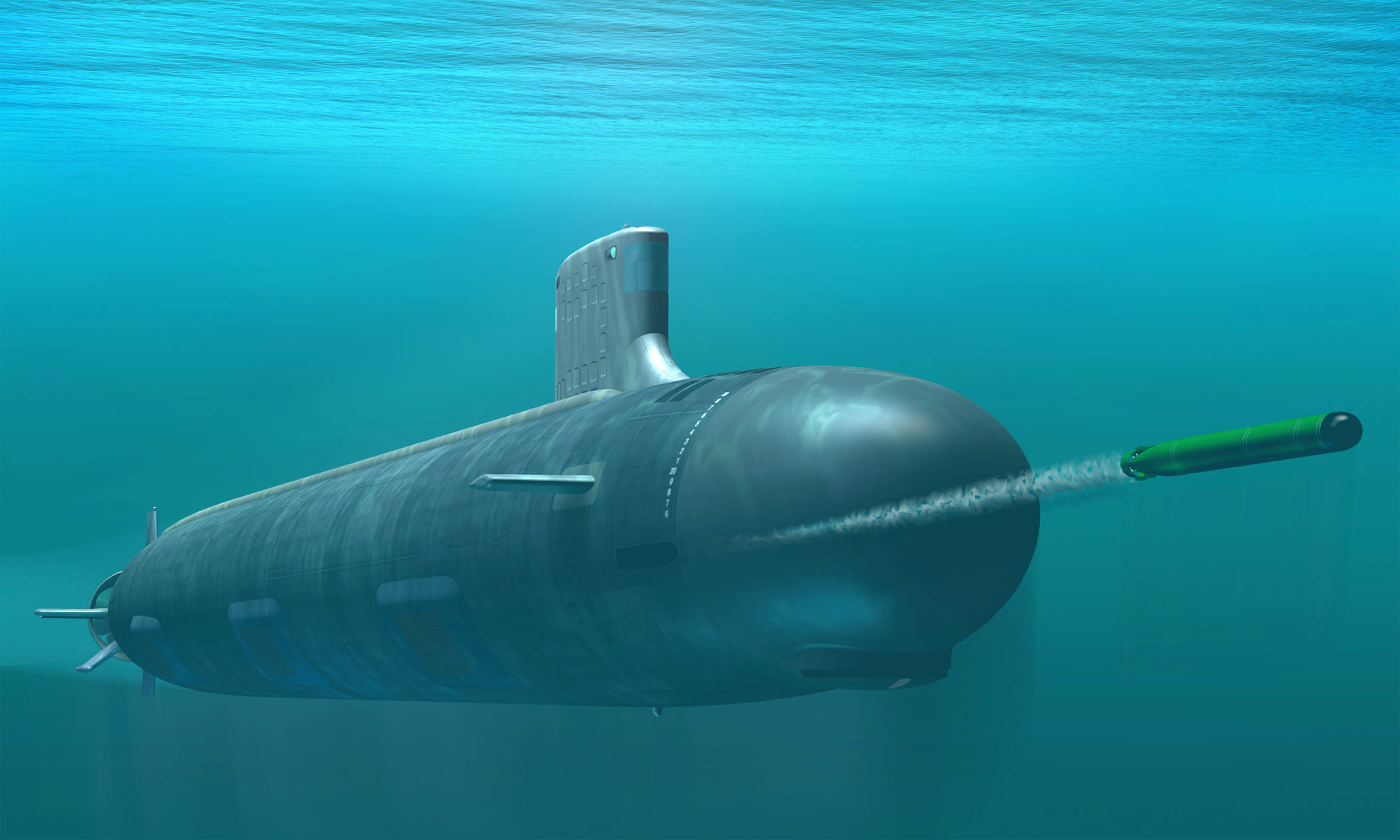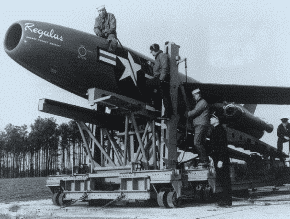|
SSGN
A cruise missile submarine is a submarine that carries and launches cruise missiles ( SLCMs and anti-ship missiles) as its primary armament. Missiles greatly enhance a vessel's ability to attack surface combatants and strike land targets, and although torpedoes are a more stealthy option, missiles give a much longer stand-off range, as well as the ability to engage multiple targets on different headings at the same time. Many cruise missile submarines retain the capability to deploy nuclear warheads on their missiles, but they are considered distinct from ballistic missile submarines due to the substantial differences between the two weapons systems' characteristics. Originally early designs of cruise missile submarines had to surface to launch their missiles, while later designs could do so underwater via dedicated vertical launching system (VLS) tubes. Many modern attack submarines can launch cruise missiles (and dedicated anti-ship missiles) from their torpedo tubes while so ... [...More Info...] [...Related Items...] OR: [Wikipedia] [Google] [Baidu] |
Regulus Missile Submarines
The Regulus missile submarines were a group of submarines operated by the United States Navy (US Navy) capable of carrying the Regulus cruise missile. Between 1959 and 1964, a total of five boats were used to undertake the first submarine-based nuclear deterrent patrols by the United States. Regulus submarines were used for this task until 1964, when sufficient ballistic missile submarines carrying the Polaris ballistic missile became available. History Regulus missile development and submarine use In May 1947, the United States Army (US Army) awarded a contract for the development of a guided cruise missile, the MGM-1 Matador. The US Navy saw this as a threat to its role in the operation of guided missiles, and launched its own development program for a turbojet powered missile, which it called Regulus. In August 1947, specifications for the Regulus project were issued: *Be capable of carrying a warhead *Have a range of *Have a maximum speed of Mach 0.85 *A CEP of 0.5% of the ... [...More Info...] [...Related Items...] OR: [Wikipedia] [Google] [Baidu] |
Virginia-class Submarine
The ''Virginia'' class, also known as the SSN-774 class, is a class of nuclear-powered cruise missile fast-attack submarines, in service in the United States Navy. Designed by General Dynamics Electric Boat (EB) and Huntington Ingalls Industries, the ''Virginia'' class is the United States Navy's latest submarine model, which incorporates the latest in stealth, intelligence gathering, and weapons systems technology. ''Virginia''-class submarines are designed for a broad spectrum of open-ocean and littoral missions, including anti-submarine warfare and intelligence gathering operations. They are scheduled to replace older s, many of which have already been decommissioned. ''Virginia''-class submarines will be acquired through 2043, and are expected to remain in service until at least 2060, with later submarines expected to remain into the 2070s. History The class was developed under the codename Centurion, later renamed New SSN (NSSN). The "Centurion Study" was initiated ... [...More Info...] [...Related Items...] OR: [Wikipedia] [Google] [Baidu] |
Hull Classification Symbol
The United States Navy, United States Coast Guard, and United States National Oceanic and Atmospheric Administration (NOAA) use a hull classification symbol (sometimes called hull code or hull number) to identify their ships by type and by individual ship within a type. The system is analogous to the pennant number system that the Royal Navy and other European and Commonwealth navies use. History United States Navy The U.S. Navy began to assign unique Naval Registry Identification Numbers to its ships in the 1890s. The system was a simple one in which each ship received a number which was appended to its ship type, fully spelled out, and added parenthetically after the ship's name when deemed necessary to avoid confusion between ships. Under this system, for example, the battleship ''Indiana'' was USS ''Indiana'' (Battleship No. 1), the cruiser ''Olympia'' was USS ''Olympia'' (Cruiser No. 6), and so on. Beginning in 1907, some ships also were referred to alternative ... [...More Info...] [...Related Items...] OR: [Wikipedia] [Google] [Baidu] |
Submarine-launched Cruise Missile
A submarine-launched cruise missile (SLCM) is a cruise missile that is launched from a submarine (especially a SSG or SSGN). Current versions are typically standoff weapons known as land-attack cruise missiles (LACMs), which are used to attack predetermined land targets with conventional or nuclear payloads. Anti-ship cruise missiles (ASCMs) are also used, and some submarine-launched cruise missiles have variants for both functions. History of development The U.S. Navy's first land-attack cruise missile submarines (4 SSG and 1 SSGN) deployed with the Regulus missile from 1958 until retired in 1964 with the arrival of the Polaris ballistic missile submarines (SSBNs) in the Pacific. The US deployed the short-range Harpoon anti-ship missile on submarines beginning in 1981. The Soviet Navy converted 13 Whiskey-class submarines (Project 613) for the land-attack cruise missile (LACM) role in the late 1950s (Whiskey Single Cylinder, Whiskey Twin Cylinder, Whiskey Long Bin), arm ... [...More Info...] [...Related Items...] OR: [Wikipedia] [Google] [Baidu] |
Ballistic Missile Submarine
A ballistic missile submarine is a submarine capable of deploying submarine-launched ballistic missiles (SLBMs) with nuclear warheads. The United States Navy's hull classification symbols for ballistic missile submarines are SSB and SSBN – the ''SS'' denotes submarine, the ''B'' denotes ballistic missile, and the ''N'' denotes that the submarine is nuclear powered. These submarines became a major weapon system in the Cold War because of their nuclear deterrence capability. They can fire missiles thousands of kilometers from their targets, and acoustic quieting makes them difficult to detect (see acoustic signature), thus making them a survivable deterrent in the event of a first strike and a key element of the mutual assured destruction policy of nuclear deterrence. The deployment of SSBNs is dominated by the United States and Russia (following the collapse of the Soviet Union). Smaller numbers are in service with France, the United Kingdom, China and India; North Ko ... [...More Info...] [...Related Items...] OR: [Wikipedia] [Google] [Baidu] |
SSM-N-8 Regulus
The SSM-N-8A Regulus or the Regulus I was a United States Navy-developed ship-and-submarine-launched, nuclear-capable turbojet-powered second generation cruise missile, deployed from 1955 to 1964. Its development was an outgrowth of U.S. Navy tests conducted with the German V-1 missile at Naval Air Station Point Mugu in California. Its barrel-shaped fuselage resembled that of numerous fighter aircraft designs of the era, but without a cockpit. Test articles of the Regulus were equipped with landing gear and could take off and land like an airplane.''Regulus: The First Nuclear Missile Submarines'' documentary, Spark, 2002 When the missiles were deployed they were launched from a rail launcher, and equipped with a pair of Aerojet JATO bottles on the aft end of the fuselage. History Design and development In October 1943, Chance Vought Aircraft Company signed a study contract for a range missile to carry a warhead. The project stalled for four years, however, until May 1 ... [...More Info...] [...Related Items...] OR: [Wikipedia] [Google] [Baidu] |
Tomahawk Cruise Missile
The Tomahawk () Land Attack Missile (TLAM) is a long-range, all-weather, jet-powered, subsonic cruise missile that is primarily used by the United States Navy and Royal Navy in ship and submarine-based land-attack operations. Under contract from the U.S. Navy, the Tomahawk was designed at the APL/JHU in a project led by James Walker near Laurel, Maryland, and was first manufactured by General Dynamics in the 1970s. It was intended to fill the role of a medium- to long-range, low-altitude missile that could be launched from a naval surface warfare platform, and featured a modular design accommodating a wide variety of warhead, guidance, and range capabilities. At least six variants and multiple upgraded versions of the TLAM have been added since the original design was introduced, including air-, sub-, and ground-launched variants with conventional and nuclear armaments. In 1992–1994, McDonnell Douglas Corporation was the sole supplier of Tomahawk Missiles and produced Block II ... [...More Info...] [...Related Items...] OR: [Wikipedia] [Google] [Baidu] |
Submarine
A submarine (or sub) is a watercraft capable of independent operation underwater. It differs from a submersible, which has more limited underwater capability. The term is also sometimes used historically or colloquially to refer to remotely operated vehicles and Autonomous underwater vehicle, robots, as well as medium-sized or smaller vessels, such as the midget submarine and the wet sub. Submarines are referred to as ''boats'' rather than ''ships'' irrespective of their size. Although experimental submarines had been built earlier, submarine design took off during the 19th century, and they were adopted by several navies. They were first widely used during World War I (1914–1918), and are now used in many navy, navies, large and small. Military uses include attacking enemy surface ships (merchant and military) or other submarines, and for aircraft carrier protection, Blockade runner, blockade running, Ballistic missile submarine, nuclear deterrence, reconnaissance, conventio ... [...More Info...] [...Related Items...] OR: [Wikipedia] [Google] [Baidu] |
Operation Odyssey Dawn
Operation Odyssey Dawn was the U.S. code name for the American role in the international military operation in Libya to enforce United Nations Security Council Resolution 1973 during the initial period of 19–31 March 2011, which continued afterwards under NATO command as Operation Unified Protector. The initial operation implemented a no-fly zone that was proposed during the Libyan Civil War to prevent government forces loyal to Muammar Gaddafi from carrying out air attacks on anti-Gaddafi forces. On 19 March 2011, several countries prepared to take immediate military action at a summit in Paris. Operations commenced on the same day with a strike by French fighter jets, then US and UK forces conducting strikes from ships and submarines via 110 Tomahawk cruise missiles and air assets bombing Gaddafi forces near Benghazi. The goal of coalition forces was to impose a no-fly zone for Libyan government forces. The U.S. initially had strategic command of the military interventi ... [...More Info...] [...Related Items...] OR: [Wikipedia] [Google] [Baidu] |
USS Florida (SSGN-728) Boat Enh
Several United States Navy ships have borne the name ''Florida'', in honor of the state of Florida: *''Florida'' (1824) was a sloop that served on survey duty between 1824 and 1831. Her final cruise, between 1 June 1830 and 31 May 1831, was under the command of Lieutenant T. R. Gedney. * was a side-wheel steamboat purchased in 1861 and sold after 1867. * was originally the screw frigate USS ''Wampanoag'', renamed in 1869, and sold in 1885. * was an monitor commissioned in 1903, renamed to USS ''Tallahassee'' in 1908, redesignated as IX-16 in 1921 and decommissioned and sold in 1922. * was the lead ship of her class of battleship, commissioned 1911 and scrapped in 1932. * is an cruise missile submarine, originally commissioned in 1983 as a ballistic missile submarine A ballistic missile submarine is a submarine capable of deploying submarine-launched ballistic missiles (SLBMs) with nuclear warheads. The United States Navy's hull classification symbols for ballisti ... [...More Info...] [...Related Items...] OR: [Wikipedia] [Google] [Baidu] |
Unmanned Aerial Vehicle
An unmanned aerial vehicle (UAV), commonly known as a drone, is an aircraft without any human pilot, crew, or passengers on board. UAVs are a component of an unmanned aircraft system (UAS), which includes adding a ground-based controller and a system of communications with the UAV. The flight of UAVs may operate under remote control by a human operator, as remotely-piloted aircraft (RPA), or with various degrees of autonomy, such as autopilot assistance, up to fully autonomous aircraft that have no provision for human intervention. UAVs were originally developed through the twentieth century for military missions too "dull, dirty or dangerous" for humans, and by the twenty-first, they had become essential assets to most militaries. As control technologies improved and costs fell, their use expanded to many non-military applications.Hu, J.; Bhowmick, P.; Jang, I.; Arvin, F.; Lanzon, A.,A Decentralized Cluster Formation Containment Framework for Multirobot Systems IEEE T ... [...More Info...] [...Related Items...] OR: [Wikipedia] [Google] [Baidu] |
_Boat_Enh.jpg)








